There has been rapid growth in the penetration of telephony services in the last few years. But the growth has not been exponential in the quality of service offered or openness of business. Consumers are not satisfied with the operators’ services and schemes.
Traditionally, consumers are required to give up their mobile number on changing service providers. As a result, they are hugely inconvenienced by having to inform everyone about the change in their number. Besides there is likelihood of important calls (from people who didn’t have the new number) being missed out, and so on. The picture has now changed dramatically with the introduction of mobile number portability (MNP).

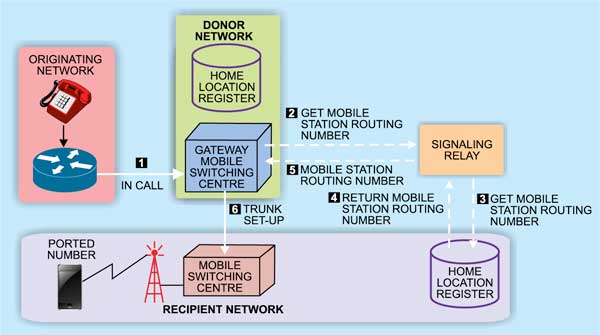
Mobile number portability
Mobile number portability enables consumers to retain their mobile numbers when changing service providers, service types and/or locations. The Internet Engineering Task Force (IETF) has defined three types of number portability: service provider portability, location portability and service portability.
Service provider portability. It enables a customer to retain his existing mobile number when changing from one service provider to another in the same area.
Location portability. It enables a customer to retain his existing mobile number without impairment of quality, convenience or reliability when shifting from one geographic location to another.
MNP terminology
Donor operator. Operator from whose network the customer is porting out.
Recipient operator. Operator who will be providing services to the customer after porting.
Number portability database. Collection/repository of all the ported numbers. Provides a unique routing number in response to a query from any network operator.
Routing number. A unique number stored in the number portability database that is used to route the call to the recipient operator.
Service portability. It enables a customer to retain his existing mobile number without impairment of quality, convenience or reliability when switching from one service technology to another service technology—for example, from CDMA to GSM.
A combination of different kinds of portability options can also be used, which enables customers to retain their mobile number across different service providers, service technologies, geographical regions and national boundaries.
Many regulatory authorities have made number portability mandatory or are about to introduce it so as to ensure better quality of service to customers. The world’s first country to introduce mobile number portability was Singapore (1997). It was followed by the UK, Hong Kong and the Netherlands (1999), Spain (2000) and Australia (2001). As of today, there are many countries (including India) that have introduced number portability.
Implementation of MNP
Mobile number portability can be implemented using either decentralised database or centralised database approach (Fig. 1). Decentralised database solution requires each operator to maintain its own number portability database. It is useful if there are few operators. If there are many operators, centralised database solution is better.
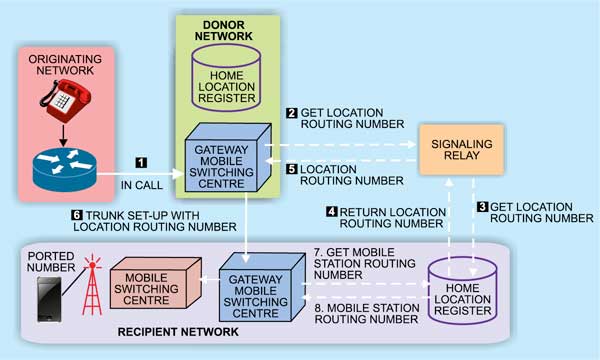
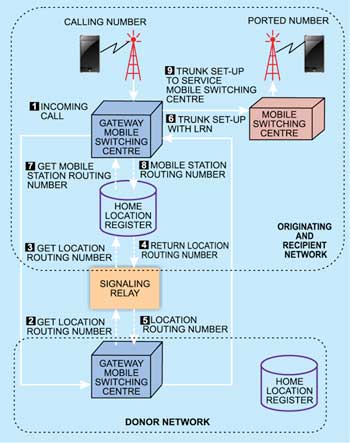
Signaling relay approach. This approach is based on decentralised database solution. In this implementation, the donor operator identifies the correct terminating network (recipient operator) and routes the call to that network. The originating network receives a call from the caller and routes the call to the donor operator. Upon receiving the call, the donor operator network identifies that the dialed number has been ported out. Now the donor operator routes the call to the recipient operator network.
In this routing scheme, there is no need of a central database, and only the donor and recipient operators need to know about the porting of a number.
Direct relay. In this approach, the originating network contacts the gateway mobile switching centre to establish a call. The gateway mobile switching centre detects that the dialed number is ported out and relays signaling information to the home location register to get the mobile station routing number. After getting the mobile station routing number, the gateway mobile switching centre sets up trunk to the serving mobile switching centre to establish the call (Fig. 2).
In this routing approach, the originating, donor and recipient operators are kept busy to establish a call. So it may not be considered as an efficient mobile number portability scheme.
Relay using location routing number. In this scheme, a location routing number is used to route the call to the correct terminating network. The call flow is shown in Fig. 3. Again, in this method of number portability, all the network elements of originating, donor and recipient networks are kept busy for the entire duration of call. Further, this approach is susceptible to establishing a tromboning call set-up when the originating network is also a recipient network (Fig. 4).
Basically, tromboning is where a call originates at a certain point, and follows a path out into the network and back to a destination close to where the call originated. In this way, several networks and their entities are kept busy unnecessarily. So this mobile number portability scheme is not recommended.
All-call-query approach. This is a direct routing scheme that utilises a centralised ported database. In this scheme, the originating network directly queries the central ported database to determine the routing number required to transfer the call to the recipient operator. After determining the routing number, the call from the originating network is directly routed to the recipient operator network. In this way, the involvement of donor operator is eliminated.
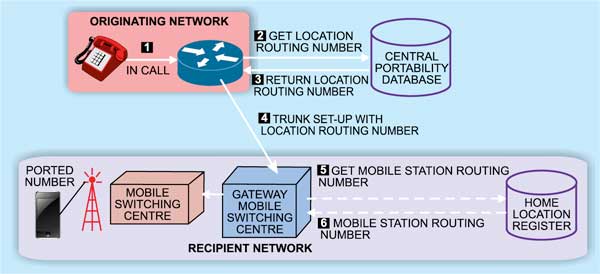
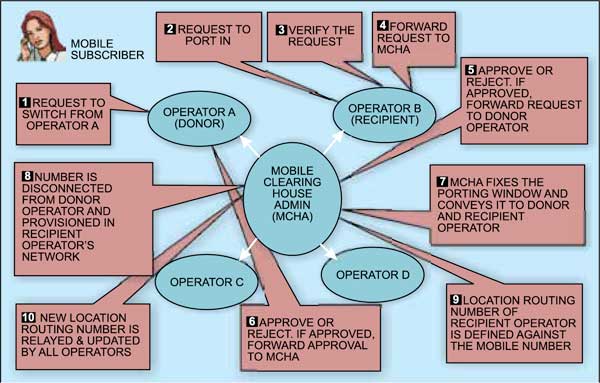
In this approach, the originating network directly queries a central portability database to get the location routing number in order to route the call to the gateway mobile switching centre of the correct terminating network. Further, the gateway mobile switching centre sets up trunk to the serving mobile switching centre to establish the call (Fig. 5).
The donor network does not take part in the call process and utilises network resources most efficiently to route a call. Thus this scheme is considered to be the most efficient routing scheme for large interconnected networks and a large number of ported numbers.
MNP in India
On March 8, 2006, the Telecom Regularity Authority of India (TRAI) issued draft regulations to facilitate mobile number portability in India and submitted its recommendations to the Department of Telecommunication (DoT). Finally, the DoT recommended service provider number portability including service portability (portability between GSM and CDMA) for all mobile service operators. It was decided to implement the all-call-query approach for mobile number portability.
The DoT has divided the whole country into two zones for MNP—north-west zone and south-east zone—and awarded licences to two vendors to work as MNP clearing house administrators. The north-west zone comprises Gujarat, Haryana, Himachal Pradesh, Jammu and Kashmir, Maharashtra, Punjab, Rajasthan, UP (East), UP (West), Delhi and Mumbai. The south-east zone comprises Andhra Pradesh, Bihar, Assam, Karnataka, Kerala, Madhya Pradesh, North East, Orissa, Tamil Nadu, West Bengal and Kolkata.
MNP clearing house administrators manage a central mobile number portability database that keeps record of all ported-in and ported-out numbers. Further, the operators also maintain their own MNP database called local number portability database.
The originating network will perform number portability database query to get the location routing number to route the call directly to the recipient network. Location routing number is a 4-digit unique number allotted by DoT to all mobile operators for each circle to identify individual networks. All ported number calls are routed on the basis of location routing number. So when the MNP database receives a query for a given mobile station international subscriber directory number (MSISDN), the database returns the MSISDN prefixed with location routing number.
Mobile number portability was started as a pilot project in Haryana on November 25, 2010 and has been implemented across the nation from January 20, 2011. The detailed MNP process is shown in Fig. 6.
At present, the only restriction is that mobile number portability is allowed within the same circle (intracircle operators). Recently, the government of India approved New Telecom Policy-2012 (NTP), which aims to abolish roaming charges across the country and facilitate nationwide (inter-circle) mobile number portability, i.e., one-nation-one-number with free roaming. This will allow users to change the operator without changing their mobile number even if they move from one circle to another. DoT has been asked to start nationwide MNP implementation and it is expected that the inter-circle MNP will start very soon.
Network architecture for MNP
Network architecture for MNP is shown in Fig. 7. The network is deployed in a redundant and synchronised way in two different geographical areas—one as a production site and the other as a disaster recovery site—to avoid interruption in service due to failure of one site.
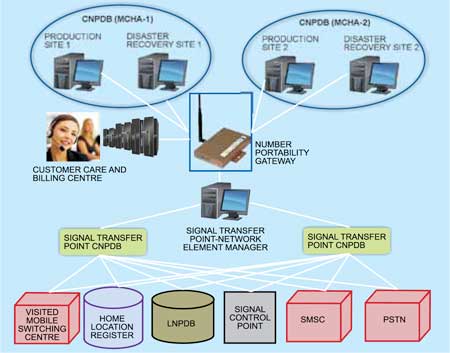
Depending upon the requirement and network topology, the service provider can either directly connect to the central number portability database (CNPDB) or deploy separate local number portability database (LNPDB) and connect it to the CNPDB through its number portability gateway. The CNPDB and LNPDB should be syn-chronised.
When a call is originated, the visited mobile switching centre interrogates an internal (LNPDB) or external database (CNPDB) to get the location routing number of the correct terminating network. The CNPDB can be integrated with the signaling transfer point and accessed via an application programming interface locally, or a query can be made to a remote CNPDB through number portability gateway using protocols like simple object access protocol and extensible markup language. Here MNP translations are performed by the signaling transfer points. The signaling transfer point receives the location routing number query from the visited mobile switching centre and routes it to the appropriate signal control point.
The signal control point is a high-transaction-oriented server that receives number portability requests from the visited mobile switching centre and passes on the mobile station routing number information to the gateway mobile switching centre handling the call. The gateway mobile switching centre then routes the call to the currently serving visited mobile switching centre of the recipient operator.
The road ahead
About a year into its operation in India, the service provider number portability has failed to enthuse customers. It is expected to gain momentum once the National Telecom Policy’s proposals of abolishing the inter-circle roaming charges and extending MNP to national level are implemented.
The author joined Bharat Sanchar Nigam Limited as junior telecom officer and is currently working in Ludhiana, Punjab. He holds Ph.D. degree in electronics engineering from Indian Institute of Technology-BHU, Varanasi, India, and has authored and co-authored more than 25 research papers







This was a great article.
However I have unique problem.
I have been trying to port my BSNL number to Jio. But whenever jio puts in a port request they get an error ‘incorrect donor’. When BSNL asked, they say that there is no problem from their end.
I have had this number for more than a year and it’s a prepaid. And I have now tried to port twice. Both times the same problem.
Could you tell me what’s the problem and the solution.
An useful and esay to understand Thanks
Thank You for your feedback.